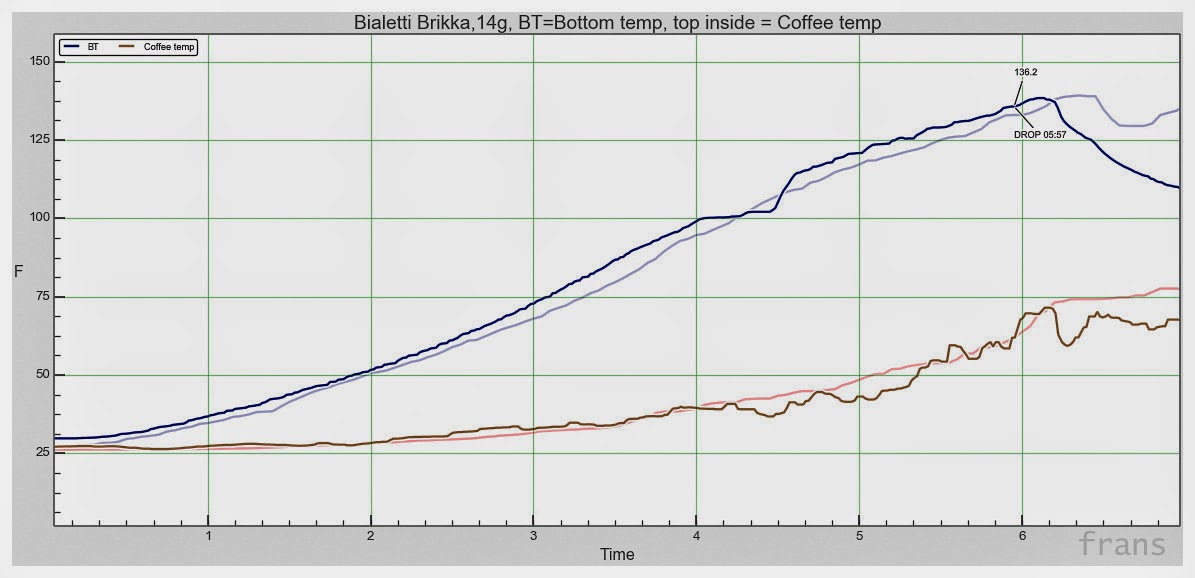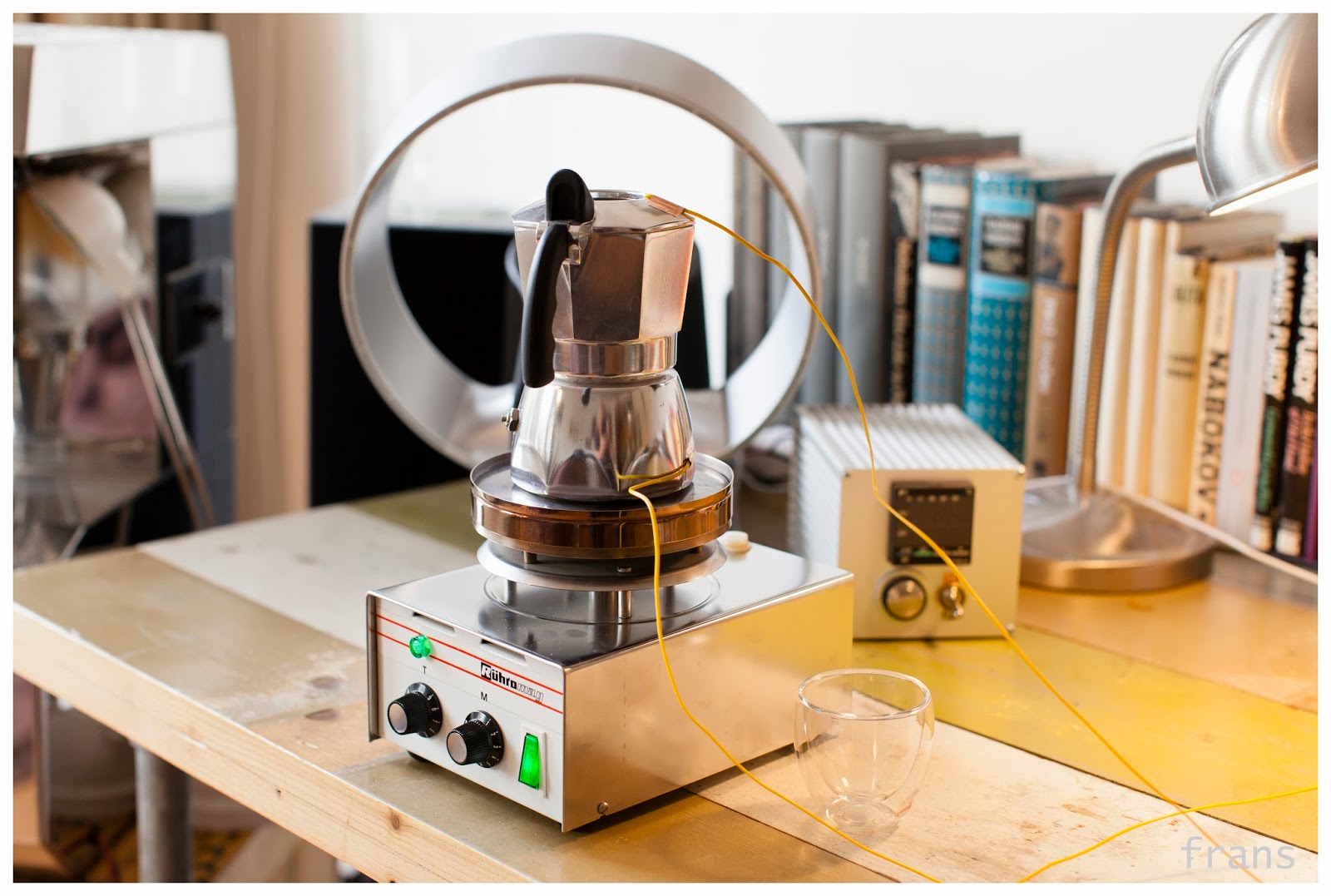Theo, a friend who has a Rocket E61 espresso machine at home, is packing to spend four weeks in Denmark. He and his young wife will stay a fortnight in a nice little house in the countryside and then move on for another two weeks in a rental house in another part of the country before returning home.
He will probably miss the great coffee from his home machine but taking it along is no option because of the weight.
Inspired by the wonderful "Back to the Moka Pot" action video made by Laczkó Gábor in Hungary I advised him to buy a little Moka pot and I decided to try mine out with my current beans and grinders.
Before, I had just used a small gas stove but because it is almost impossible to determine exactly how much heat is generated with it, I looked around for an alternative.
I dislike the Harrio Beam Heater that one can find in some specialty cafes. To me it looks too much like a gimmick and the design suggests to me it's a trinket someone won in a trailer park raffle.
I did come across a few second hand laboratory hot plates. These are designed by engineers who keep it functional, not dressing up the tool in gold metal miniskirts with fancy lights.
So I bought an old Retsch RühroMag MH12 built in Germany. Over many years it has been handled with care so no scratches, just the marks of lots of use on the brass hot plate.
The extra fun thing of it is the 'stirring' feature. Just below the hot plate there is a very strong magnet and if the device is switched on, the magnet starts to rotate slowly. A knob on the front regulates the rotation speed and it can go quite fast too.
This magnetic wonder can be put to use if you simply drop a little magnetic "flea" or stir bar in the water of the lower compartment. Then, the water in the Moka pot will be stirred, possibly heating it more efficiently and getting the coffee ready quicker and fresher.
Now this is only possible if you get a Moka pot that is made of non-magnetic material, like aluminum. You want the "flea" to be stirring the water, not the moka pot itself being stirred around the flea. I have a Moka pot with a beautiful design by Alesssi but that one is made of stainless steel and best used on an induction plate. The other is only a little smaller, a Brikka by Bialetti, just like the one used by Laczkó Gábor in his video. It is a little cheaper but what's more important, it has a little pressure valve on the spout in the upper chamber which creates extra pressure in the cofee puck during extraction and even a little crema on the espresso.
So I decided to use the Brikka.
Following Gábor's great example, I fastened two (not four like he did) thermo-probes on the Moka pot. One on the outside of the lower chamber and one through the top very close to the bottom of the top compartment but not touching it. This way, the low probe would measure Bottom Temperature as a result of heat from the hot plate and the high probe would measure the temperature in the top chamber, jumping up in temperature as soon as the espresso fluid would engulf it.
Then I connected these to the free (!) Artisan Roaster Scope software which I installed on a spare laptop. I could have used the laptop that has Artisan controlling my coffee roaster but then I'm afraid I would need to change the setup every time I switched from roasting beans to tracking the Moka pot.
I want to tip my hat for the designers of the Moka pot as it behaves very nicely, delivering a sweet tasting brew that's almost espresso, from the Ethiopia Sidamo 2 "Moplaco" beans roasted by Björn Aarts for Trakteren in Amsterdam. I loved it and drank it up even though I have some espresso machines in the room, the biggest of them hot and ready to pull.
The hot plate starts at room temp a little over 26ºC, then heats up the bottom half and at about 4 minutes a temperature of 100ºC is reached, pressure builds up and then the temperature climbs again, around 135ºC the pressure is high enough to overcome the pressure valve and suddenly, in a brief flow, the espresso and crema rushes into the top chamber at 70-75ºC, ready to pour and taste immediately.
It's important to be there all the time and stop the hot plate promptly, taking off the Moka pot and placing it on a metal surface after pouring out the espresso.
The Artisan software (or, after more tests have proven the procedure is consistent, a timer) can warn you when it is time to have a preheated cup ready for the pour.
I have ordered a few "fleas" to try out the stirring and to check if that improves the procedure.
Thanking Laczkó Gábor for inspiration, Marko Luther for Artisan and you for reading!
He will probably miss the great coffee from his home machine but taking it along is no option because of the weight.
Inspired by the wonderful "Back to the Moka Pot" action video made by Laczkó Gábor in Hungary I advised him to buy a little Moka pot and I decided to try mine out with my current beans and grinders.
Before, I had just used a small gas stove but because it is almost impossible to determine exactly how much heat is generated with it, I looked around for an alternative.
I dislike the Harrio Beam Heater that one can find in some specialty cafes. To me it looks too much like a gimmick and the design suggests to me it's a trinket someone won in a trailer park raffle.
I did come across a few second hand laboratory hot plates. These are designed by engineers who keep it functional, not dressing up the tool in gold metal miniskirts with fancy lights.
So I bought an old Retsch RühroMag MH12 built in Germany. Over many years it has been handled with care so no scratches, just the marks of lots of use on the brass hot plate.
The extra fun thing of it is the 'stirring' feature. Just below the hot plate there is a very strong magnet and if the device is switched on, the magnet starts to rotate slowly. A knob on the front regulates the rotation speed and it can go quite fast too.
This magnetic wonder can be put to use if you simply drop a little magnetic "flea" or stir bar in the water of the lower compartment. Then, the water in the Moka pot will be stirred, possibly heating it more efficiently and getting the coffee ready quicker and fresher.
Now this is only possible if you get a Moka pot that is made of non-magnetic material, like aluminum. You want the "flea" to be stirring the water, not the moka pot itself being stirred around the flea. I have a Moka pot with a beautiful design by Alesssi but that one is made of stainless steel and best used on an induction plate. The other is only a little smaller, a Brikka by Bialetti, just like the one used by Laczkó Gábor in his video. It is a little cheaper but what's more important, it has a little pressure valve on the spout in the upper chamber which creates extra pressure in the cofee puck during extraction and even a little crema on the espresso.
So I decided to use the Brikka.
Following Gábor's great example, I fastened two (not four like he did) thermo-probes on the Moka pot. One on the outside of the lower chamber and one through the top very close to the bottom of the top compartment but not touching it. This way, the low probe would measure Bottom Temperature as a result of heat from the hot plate and the high probe would measure the temperature in the top chamber, jumping up in temperature as soon as the espresso fluid would engulf it.
Then I connected these to the free (!) Artisan Roaster Scope software which I installed on a spare laptop. I could have used the laptop that has Artisan controlling my coffee roaster but then I'm afraid I would need to change the setup every time I switched from roasting beans to tracking the Moka pot.
I want to tip my hat for the designers of the Moka pot as it behaves very nicely, delivering a sweet tasting brew that's almost espresso, from the Ethiopia Sidamo 2 "Moplaco" beans roasted by Björn Aarts for Trakteren in Amsterdam. I loved it and drank it up even though I have some espresso machines in the room, the biggest of them hot and ready to pull.
 |
| Two extractions. Blue/blue-grey lines is bottom, brown lines is the top with espresso at 6 minutes, 70-75ºC |
The hot plate starts at room temp a little over 26ºC, then heats up the bottom half and at about 4 minutes a temperature of 100ºC is reached, pressure builds up and then the temperature climbs again, around 135ºC the pressure is high enough to overcome the pressure valve and suddenly, in a brief flow, the espresso and crema rushes into the top chamber at 70-75ºC, ready to pour and taste immediately.
 |
| Espresso from Bialetti Brika |
The Artisan software (or, after more tests have proven the procedure is consistent, a timer) can warn you when it is time to have a preheated cup ready for the pour.
 |
| Bialetti Moka pot, espresso and Retsch RühroMag MH12 stirring hot plate |
Thanking Laczkó Gábor for inspiration, Marko Luther for Artisan and you for reading!

